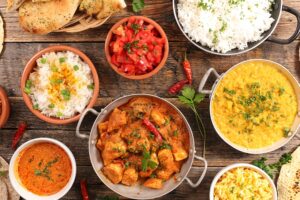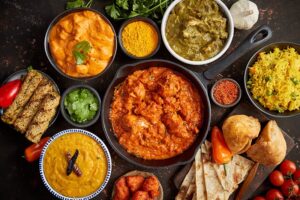Indian and Pakistani foods are loved worldwide for their tasty flavors, strong spices, and many different dishes. These foods taste the way they do because of influences from many different cultures and a long history. Throughout history, India and Pakistan have had various rulers who have influenced their food. This has led to a mix of flavors and ingredients loved by people all over the world. This article will look at the history of Indian and Pakistani food. We will see how different influences have shaped these cuisines and made them popular.
The origins of Indian and Pakistani cuisine can be traced back thousands of years, to ancient civilizations such as the Indus Valley civilization and the Vedic period. These early civilizations laid the foundation for the culinary traditions that have evolved over the millennia. Early civilizations used spices like turmeric, cumin, and coriander and cooking methods like tandoori and clay pot baking.
As trade routes opened up and new ingredients were introduced, Indian and Pakistani cuisines evolved, incorporating new flavors and techniques from around the world. Today, these cuisines are a testament to the rich tapestry of cultures and influences that have shaped the region’s culinary heritage. Over many years, India and Pakistan have been influenced by many cultures. Persian, Arab, and Central Asian invasions, as well as British colonial rule, have all played a role.
The Mughal Empire greatly influenced Indian and Pakistani food by introducing dishes like curries, kebabs, and biryanis that are now popular in the region. During British rule, tea, potatoes, and tomatoes were introduced to Indian and Pakistani cooking and are now important ingredients in their dishes. By learning about the history of these foods, we can understand how different cultures and influences have shaped Indian and Pakistani cuisine into something special and beloved.
by Lucas MARULIER (https://unsplash.com/@lu_pictures)
The Spice Culture of India and Pakistan
Spices have played a significant role in the culinary traditions of India and Pakistan for many centuries, weaving a tapestry of flavor that reflects a rich cultural heritage. The warm weather and fertile soil in the region make it perfect for growing many spices. These spices enhance the flavor of food and make it more interesting for many people. Turmeric, cumin, coriander, and cardamom are popular spices that add unique flavors and aromas to food.
Not only do these spices enhance the taste of food, but they are also valued for their potential health benefits, having been used in traditional Ayurvedic medicine for their healing properties, which promote overall well-being and balance in the body.
In addition to their culinary significance, the spice trade holds a prominent place in the historical development and evolution of Indian and Pakistani cuisine. The region’s geographical location, serving as a pivotal crossroads between the East and West, provided a unique opportunity for trade to flourish. Traders from Europe, the Middle East, and Asia were all attracted to the plentiful spices readily available in this region, sparking a vibrant exchange of goods and cultural influences. This extensive trade network allowed for the introduction of new and exotic spices and ingredients to enter the local culinary scene, resulting in a rich tapestry of flavors and culinary traditions that continue to shape the cuisine of India and Pakistan to this day.
The Influence of Invasions and Migrations
Throughout the extensive history of the Indian subcontinent, there have been countless instances of invasions and conquests by powerful empires from various parts of the world. From the imposing Mughals to the strategic Persians and the colonial British, these foreign forces brought significant changes to the political structure and societal norms of both India and Pakistan. However, their influence was not limited to just these areas, as the culinary traditions of these regions were also greatly impacted by the introduction of new ingredients, cooking techniques, and cultural practices. The blending of different elements resulted in tasty food that many people enjoy.
The Mughal Empire, a powerful dynasty that ruled over India for more than three centuries, had a profound influence on the cuisine of the region. The Mughals introduced slow-cooking methods and the use of nuts and dried fruits in savory dishes, creating rich and flavorful meals. They introduced dishes such as biryani, kebabs, and korma, which are loved by many people in India and Pakistan.
Persian cuisine has significantly impacted the cooking of India and Pakistan. They use fancy ingredients like saffron, rose water, and dried fruits in dishes like pulao and biryani. These ingredients bring a sense of luxury and sophistication to the cuisine, reflecting the cultural exchange between Persian and Indian/Pakistani culinary traditions throughout history.
Additionally, the era of British colonial rule in the region introduced a whole new range of ingredients, transforming the culinary landscape of both India and Pakistan. The arrival of potatoes, tomatoes, and chilies from the British empire led to the development of innovative fusion dishes that blended traditional Indian and British flavors in a harmonious way. This fusion cuisine showcases the adaptability and creativity of the Indian and Pakistani people in embracing new ingredients and techniques to create unique and exciting dishes that reflect the diverse influences present in the region’s history.
Millions of people moved across borders, bringing their recipes and cooking styles. This led to a blend of different culinary practices, resulting in a fusion cuisine that blends the distinct flavors and ingredients of both regions, giving birth to a diverse and delectable culinary tapestry that is uniquely Indian and Pakistani at the same time.
Regional Variations in Indian and Pakistani Cuisine
India and Pakistan, two neighboring countries in the vast and diverse region of South Asia, are renowned for their rich cultural heritage and varied culinary traditions. The unique flavors and dishes found in these countries result from centuries of influences stemming from factors such as climate, geography, and cultural practices, which have shaped the way people eat and cook in different regions.
In Northern India, the cuisine reflects a strong influence from the Mughlai and Persian culinary traditions, known for their rich and aromatic flavors that have been passed down through generations. This influence can be observed in popular dishes like tandoori chicken, a marinated and grilled chicken dish bursting with spices and flavors, and naan bread, a traditional leavened flatbread that complements curries and other dishes perfectly. The combination of exotic spices and cooking techniques creates a unique culinary experience that is distinct to the Northern region.
Southern Indian food tastes different from Northern Indian food. Coconut, curry leaves, and tamarind are common ingredients in many recipes. Dosas are thin crepes made from rice and lentils that are well-liked in South Indian cuisine. Typically, they are typically consumed with coconut chutney and sambar. Sambar is a soup-like dish made from lentils, tamarind, and spices. The tangy and spicy notes found in Southern Indian dishes contrast sharply with the richer and more robust flavors of Northern Indian cuisine, showcasing the diversity and complexity of culinary traditions within India.
Pakistani cuisine, deeply rooted in the culinary traditions of the Punjab region which stretches across both India and Pakistan, is known for its bold and hearty flavors, utilizing aromatic spices to create a symphony of tastes and aromas. Iconic dishes such as butter chicken and biryani are cherished in both countries, highlighting the shared cultural heritage. The cuisine of the Punjab region is celebrated for its generous use of ghee, or clarified butter, which lends a rich and indulgent flavor to many dishes. Moreover, the culinary traditions of this region emphasize the art of slow cooking, allowing the flavors to develop and intensify over time, resulting in mouthwatering and soul-satisfying meals.
The Global Appeal of Indian and Pakistani Cuisine
The unique and diverse culinary traditions of India and Pakistan have transcended borders, earning them global recognition and admiration for their rich flavors and diverse ingredients. The popularity of Indian and Pakistani cuisine has grown rapidly in recent years, resulting in numerous Indian and Pakistani restaurants around the world that offer a wide array of traditional dishes. These restaurants provide a platform for people from different cultural backgrounds to experience and appreciate the rich and vibrant flavors of these regions, fostering a sense of culinary unity and appreciation on a global scale.
In major cities around the world, from New York to London to Sydney, Indian and Pakistani restaurants have become culinary hotspots, drawing food enthusiasts and adventurous eaters eager to savor the unique and flavorful dishes. The widespread popularity of dishes such as chicken tikka masala, butter chicken, and biryani is a testament to the universal appeal of Indian and Pakistani cuisine. The combination of aromatic spices, rich flavors, and intricate cooking techniques creates a memorable dining experience that leaves a lasting impression on those fortunate enough to taste these culinary delights.
Furthermore, the rise of Indian and Pakistani cuisine on the international stage has not been limited to traditional dishes. Modern chefs and culinary innovators have drawn inspiration from these rich culinary traditions, experimenting with fusion cuisine and creating innovative dishes that blend traditional flavors with contemporary techniques. This culinary experimentation has led to the emergence of a new and exciting food movement, where the boundaries of Indian and Pakistani cuisine are constantly being pushed and redefined.
by Monika Grabkowska (https://unsplash.com/@moniqa
Conclusion
In conclusion, the food history of India and Pakistan is a tapestry of flavors and influences, showcasing a rich culinary heritage that has evolved over centuries. From the early civilizations to the Mughal Empire, British colonial rule, and beyond, diverse and dynamic influences have shaped Indian and Pakistani cuisine into what it is today. The fusion of culinary traditions has captivated both the local population and garnered international attention. It showcases the region’s rich and vibrant flavors in innovative ways.
The significance of food in Indian and Pakistani cultures extends beyond mere sustenance. It serves as a means of uniting people, nurturing relationships, and honoring cultural traditions. Whether it’s a festive banquet or a humble home-cooked meal, sharing food symbolizes hospitality and connection, fostering a sense of community. By appreciating the rich culinary history of these regions, we can gain a deeper understanding and appreciation for the diverse and flavorful dishes that continue to delight people worldwide.









